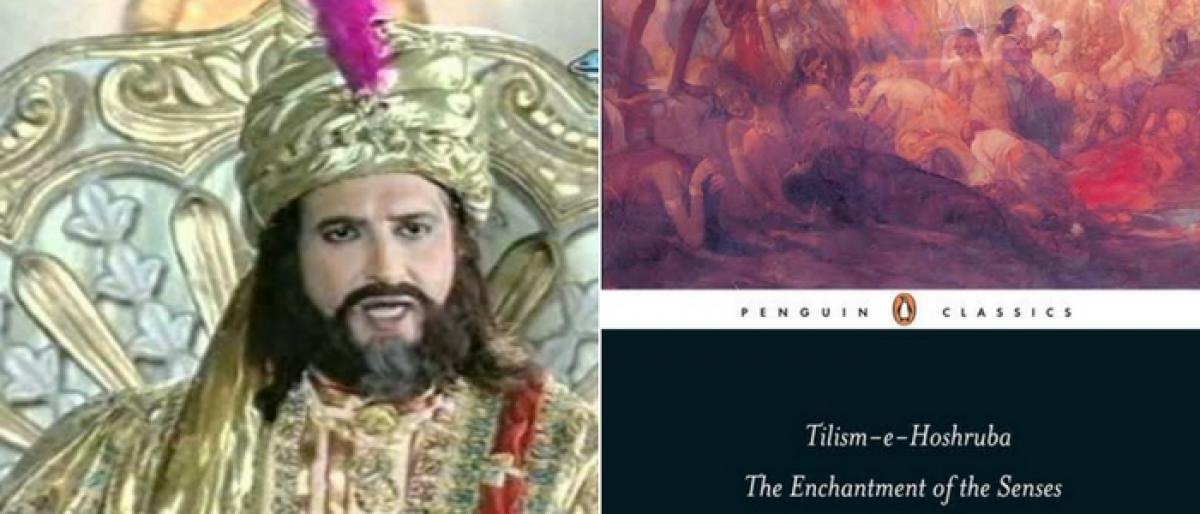Live
- Over 880,000 people displaced in Lebanon, food security deteriorates: UN
- BGT 2024-25: Bumrah picks 4-17 as Australia trail India by 83 runs in 17-wicket day
- Calcutta High Court stays order on demolition of hotels in Bengal’s Mandarmani
- AP Legislative Council Approves Key Bills
- WhatsApp Update: WhatsApp Rolls Out Group Mentions in Status Updates
- Czech PM, European Council President-elect discuss cooperation, EU priorities
- 47 killed, 22 injured in Israeli airstrikes on Lebanon's Baalbek-Hermel
- Chandrababu Advocates for Balanced Governance and Development in Andhra Pradesh
- Our 6 free services in Delhi pinching rivals: Kejriwal at 'Revadi par Charcha' campaign
- Abu Dhabi T10: Jos Buttler shines in debut, lauds England batters after memorable performances
Just In

It began as a literary hoax in 19th century Lucknow but this massive triumph of Indian imagination went on to have greater cultural impact – even beyond the subcontinent – than envisaged by its creators.
And its astonishing origin
It began as a literary hoax in 19th century Lucknow but this massive triumph of Indian imagination went on to have greater cultural impact – even beyond the subcontinent – than envisaged by its creators.
Possibly the first modern magical fantasy (introducing articles later used by Harry Potter and friends), it also showed how spin-offs can be created and stretched out – as many TV viewers have learnt.
‘Tilism-e-Hoshruba’, attributed for greater effect to Faizi, one of Emperor Akbar's “Nau Ratans”, but actually composed by a group of Lucknow's master storytellers, spread over the 19th century with an enterprising publisher weighing in, also represents a major shift in the "dastan" genre.
Apart from imparting an Indian flavour to these Arabic-Persian traditions, it marks two important shifts – direct divine intervention giving way to human ingenuity, and more significantly, women as principal protagonists in their own right.
But before taking up this magnificently entrancing story, whose name can be rendered as ‘The Mind-Blowing Wonderland’ (by literary scholar Mohammad Salim-ur-Rahman), or ‘The Enchantment of the Senses’ (by translator Shahnaz Aijazuddin), we must go into its equally captivating provenance.
For this, we have to credit Musharraf Ali Farooqi, who, apart from being a gifted author, is also an indefatigable literary detective. The first translator of the ‘Tilism...’ into English, he also traces its origin in early 19th century Lucknow, when the Nawabs still held sway, to its revival and popularisation over a half a century later.
"...from 1883-1893 in Lucknow, two rival storytellers, Muhammad Husain Jah and Ahmed Husain Qamar, wrote a fantasy in the Urdu language whose equal has not been heard before or since.
It was called Tilism-e-Hoshruba and it was over 8,000 pages long. This tale had been passed down to them – or so everyone thought – from storytellers going back hundreds of years.
"But in truth, the Tilism-e-Hoshruba was a monstrously elaborate literary hoax perpetrated by a small, tightly-knit group of storytellers from an earlier generation," he tells us.
The ring-leader for this, he identifies, as Mir Ahmed Ali who spun this tale out of the ‘Adventures of Amir Hamza’, commemorating the bravery of the eponymous hero, the uncle of the Prophet Muhammad, but in its travels through the Islamic heartlands of the Middle East and Central Asia, getting augmented with local tales to become an "entirely fictitious legend". Arriving in India sometime by the 14th century, it gained popularity during the reign of Akbar, who took a special liking to it.
Translated into Urdu into the 19th century, it, says Farooqui, failed to impress the Lucknow storytellers, who decided its fare of jinns, giants, devs (demons in Persian mythology), paris (fairies) and so on was not very exciting, and needed augmentation, especially magic and sorcerers ("sahirs").
And this is what Ali, his prime disciples Amba Prasad Rasa and Hakim Asghar Ali Khan and their disciples, and later Jah and Qamar ended up doing.
The key focus was on "tilisms", or magical worlds, which had had existed even in Amir Hamza but as rather localised and uninteresting. Here they grew to span entire worlds.
The point of departure was the chase of the false god Laqa, chased by Amir Hamza's armies to the extent that he has to take refuge in the huge tilism ruled by great sorcerer Afrasiyab.
But instead of Amir following him, the task is entrusted to his grandson, Prince Asad, who enters the tilism with an army which promptly vanishes, and all he can count on are five "ayyars" (tricksters).
But these are led by the irrepressible Amar, with his small sack that can hold more than what its size indicates, a cloak of invisibility, shape-shifting abilities and more (sounds familiar, readers of Rowling?).
Adding complexity to the mix – and allowing the storytellers free rein – are the highs and lows of the heroes, and intra-tilism squabbles leading to open rebellion against Afrasiyab led by the redoubtable sorceress Mahrukh Magic-Eye.
Then there is a range of characters like of Mahjabeen Diamond-Robe, Malika Hairat, Sarsar Swordfighter, Sanobar Snare-Roper, Tez Nigah Dagger-Fighter (all female for that matter), while Afrasiyab himself is not just a straight, black-hearted evil villain.
It may seem too long but that is inescapable given its narrative origin, not to mention the publishing strategy of Munshi Naval Kishore of Lucknow, a sorcerer himself of the book trade.
But while Khuda Baksh Library's 11-volume set is out of print, as I sadly learnt when I had enough funds to acquire it, there is a one-volume condensation by the Uttar Pradesh Urdu Akademi, and rather luckily for non-Urdu speakers, the two splendid modern English translations by Farooqi and Aijazuddin.

© 2024 Hyderabad Media House Limited/The Hans India. All rights reserved. Powered by hocalwire.com







